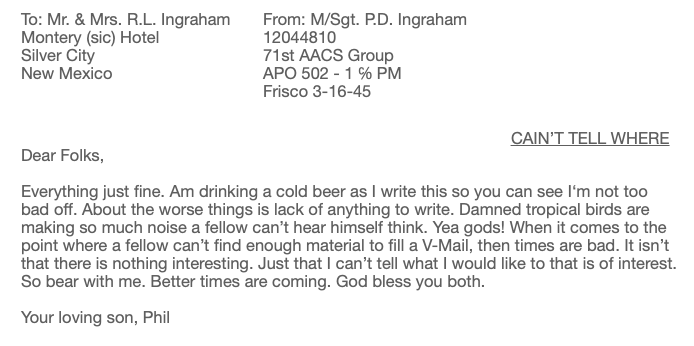V-Mail from MSgt. Philip Ingraham

My Uncle Phil — Master Sergeant Philip Ingraham — was stationed in New Caledonia with the Army Air Corps Communications Service early in 1945 when he wrote a V-Mail letter to his parents (my paternal grandparents).
Phil no doubt wrote such letters often, but only one, shown at the right, has survived. It reflects boredom, military secrecy, and Phil’s quirky sense of humor.
I think that my uncle hadn’t paid close attention in English class! The following transcription of Phil’s V-Mail has been edited for grammar and punctuation:

V-Mail was the American version of the Aerograph, which was developed by the British before the Second World War to reduce the weight and space taken up by mail sent home by air from British soldiers serving in Egypt.
The V-Mail system involved the use of special forms, measuring 17.8 cm X 23.2 cm (7" by 9 1/8"), which were filled out by correspondents. The intended recipient’s address was written in a rectangular box; the message could be written by hand or typed. V-Mail often served as greeting cards: soldiers would draw pictures or cartoons on the forms; V-Mail forms were often pre-printed with seasonal illustrations, messages, and cartoons.
When a V-Mail form was completed, it was censored and then photographed on microfilm. The undeveloped film was forwarded to a processing facility in a safe area, where it was developed. The resulting rolls of tiny negatives were then shipped by air to a printing facility to be enlarged onto light-weight sheets of photographic paper measuring 10.7 cm by 13.2 cm (4 1/4" X 5 3/16").
The resulting photographs were folded once, about a third of the way from the top, so that the recipient’s address would show through a window in the special envelopes that were made. In keeping with the practice of free mailing privileges for soldiers in combat zones, V-Mail letters posted by soldiers were were free-franked, meaning that they could be mailed without postage.
V-Mail killed multiple birds with one stone: According to the American National Postal Museum, “V-mail ensured that thousands of tons of shipping space could be reserved for war materials. The 37 mail bags required to carry 150,000 one-page letters could be replaced by a single mail sack. The weight of that same amount of mail was reduced dramatically from 2,575 pounds to a mere 45.” This saved considerable weight and bulk in a time in which both were hard to manage in a combat zone.
V-mail also deterred espionage communications by foiling the use of invisible ink, microdots, and microprinting, none of which would be reproduced in the chemical-based photography of the time. And it was seen as a morale booster, since it could be moved more quickly than regular mail between combat zones
Civilians at home could also take advantage of the V-Mail system, and could buy packets of a dozen blank forms, like the one shown at the right. Unlike the men and women in the service, however, they had to pay postage — three cents for surface mail, or six cents for air mail.
Phil’s V-Mail letter is typical: because of censorship requirements, it contains no military information. He purposely avoids saying where he is. The letter served mainly to assure my grandparents that he was alive and in good health at the time of writing.